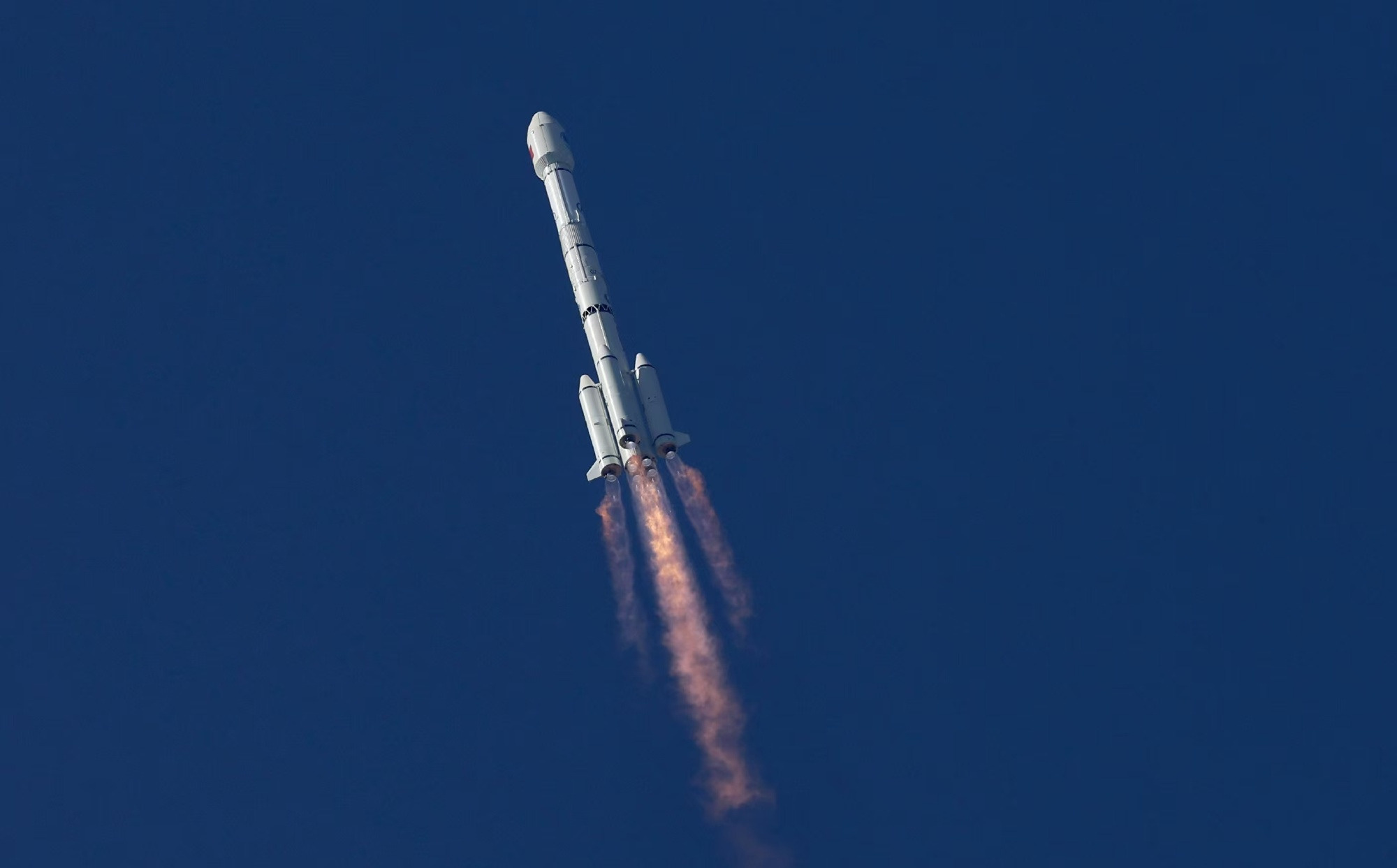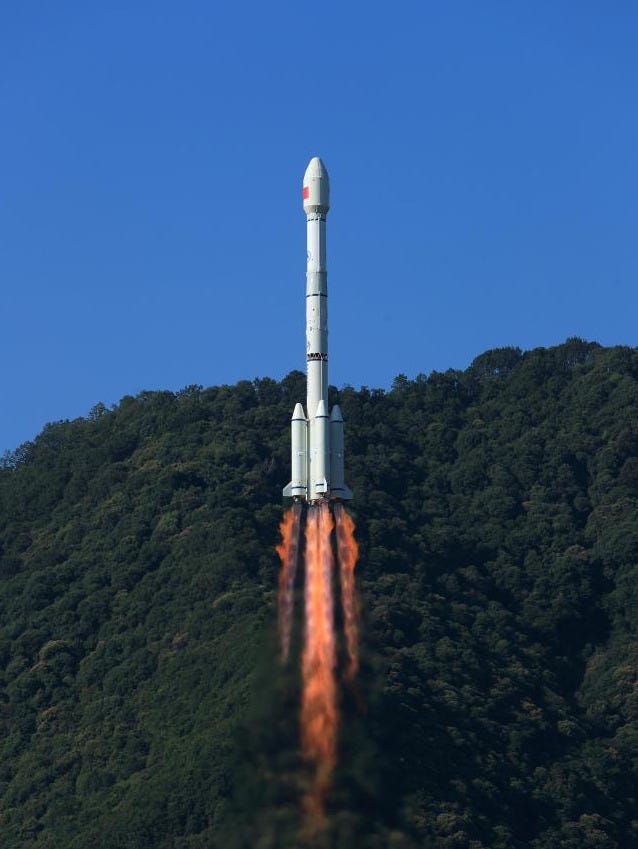Need a guide? [Long March 3B/E YZ-1 Y80]
Two more BeiDou satellites were sent to a medium Earth orbit atop of a Long March 3B/E!
At 09:14 am China Standard Time, or 01:14 am Universal Coordinate Time, on September 19th, a Long March 3B/E blasted off from Launch Complex 2 at the Xichang Satellite Launch Center. Onboard for this launch were two third-generation BeiDou navigation satellites headed to medium Earth orbit, the 59th and 60th satellites overall.
To enter medium Earth orbit, the two satellites were attached to a Yuanzheng-1 upper-stage. A Yuanzheng-1 upper-stage was used for this launch as the two BeiDou satellites lack sufficient onboard thrusters to enter their desired orbit, the third-stage of the Long March 3B/E can also only ignite its engines twice. Both of those burns would have been completed to enter a parking orbit and then heading to a medium Earth transfer orbit.
Following burns of the Yuanzheng-1 upper-stage after launch, the orbital police, Jonathan McDowell, tracked the satellites to 21,882 x 22,234 kilometers (BeiDou 59) and 21,537 x 22,199 kilometers (BeiDou 60) orbits with an inclination of 55.0 degrees.
In a rare turn of events for an in-land launch, this launch was streamed by China Central Television on Weibo. This stream started a little over thirty-eight minutes before launch, with it ending not long after second-stage ignition and separation. Despite not lasting very long into the flight, many incredible views were provided (if you have the time I’d recommend rewatching it).
According to the China Satellite Navigation Office, the two BeiDou satellites launched today were the last of the third generation and will test some technologies for the fourth generation. Some upgrades present on the satellites are reportedly upgraded atomic clocks and new inter-satellite link terminals.
Fifty BeiDou satellites are believed to be in active service as of today’s launch, the ones launched today will undergo a period of on-orbit testing and verification before entering service. Satellites part of the third-generation BeiDou network are believed to have a lifespan of ten years and will last into the early 2030s, with twenty-eight in orbit.
Details about the fourth-generation BeiDou network are sparse but part of the aims of the next generation will be to support indoor, underwater, and deep-space navigation. Liu Yingchun, Chief Designer of the third-generation BeiDou network, spoke to China Media Group and said the following about the next generation:
"We will enter the deployment of BDS-4, with the two satellites serving as the last additions to BDS-3," — “Therefore, they will also conduct technical verification and exploration besides the regular operations in the constellation.”
The fourth-generation BeiDou network is currently expected to provide superior positioning, navigation, and timing services before 2035. China’s various low Earth orbit mega-constellations are also expected to be a key part of the network’s centimeter-level positioning service.
After launch, the China Academy of Launch Vehicle Technology was keen to point out that the Long March 3A series of launch vehicles (consisting of the Long March 3A, 3B, and 3C) have performed forty-seven BeiDou launches, carrying sixty-four satellites, for a one hundred percent success rate.
This was the 535th launch of a Long March rocket overall, the 98th launch of a Long March 3B, and the 41st launch from China this year.
Liftoff video via 文昌国际航天城 on Weibo.
CCTV13’s coverage of the launch mission via 卡尔达瓦里希 on Weibo.
Check out the previous Long March 3B/E launch
More Internet? [LM-3B/E Y97]
On August 1st, at 21:14 pm China Standard Time, or 13:14 pm Universal Coordinated Time, a Long March 3B/E lifted off from Launch Complex 2 at the Xichang Satellite Launch Center. Onboard the rocket was the second ‘Internet high-orbit satellite’ (Weixing…
What is the Long March 3B/E?
This section is for those less familiar with China's Long March series of launch vehicles.
The Long March 3B is an older-generation geostationary orbit workhorse of the China Academy of Launch Vehicle Technology. The first two stages and four boosters of the rocket burn Dinitrogen Tetroxide and Unsymmetrical Dimethylhydrazine, with liquid hydrogen and liquid oxygen in the third-stage.
Over the rocket's almost twenty-eight-year launch history, two versions of the vehicle have flown, the 3B and 3B/E. Since 2012 only the 3B/E variant has flown due to its increased payload capacity. The payload capacity of the launch vehicle is currently as follows:
11,500 kilograms to low Earth orbit
7,100 kilograms to a sun-synchronous orbit
5,500 kilograms into a geostationary transfer orbit
2,000 kilograms into geostationary orbit
The first-stage is powered by four YF-21C engines that burn Dinitrogen Tetroxide and Unsymmetrical Dimethylhydrazine to generate 302 tons of thurst, while the boosters are powered by one YF-25 engine burning the same fuel to generate 72 tons of thrust each. Combined the four boosters and first stage generate a thrust of 590 tons. The second stage is powered by one YF-22E and four YF-23F vernier engines that also burn Dinitrogen Tetroxide and Unsymmetrical Dimethylhydrazine to generate 81 tons of thrust. The third-stage is powered by two YF-75 engines that burn liquid hydrogen and liquid oxygen to generate 17 tons of thrust.
On the launch pad, the Long March 3B/E is 56.3 meters tall and weighs 458,970 kilograms when fully fuelled. The first and second-stage have a diameter of 3.35 meters, while the third-stage has a diameter of 3 meters, along with the four boosters diameter of 2.25 meters, and the fairing has a diameter of 4.2 meters.
So far every Long March 3B launch has occurred from the Xichang Satellite Launch Center, in the south of Sichuan province.






![More Internet? [LM-3B/E Y97]](https://substackcdn.com/image/fetch/$s_!SjNB!,w_1300,h_650,c_fill,f_auto,q_auto:good,fl_progressive:steep,g_auto/https%3A%2F%2Fsubstack-post-media.s3.amazonaws.com%2Fpublic%2Fimages%2F9a947f28-e6ab-4501-b5fe-e6c861f74036_1080x608.webp)
